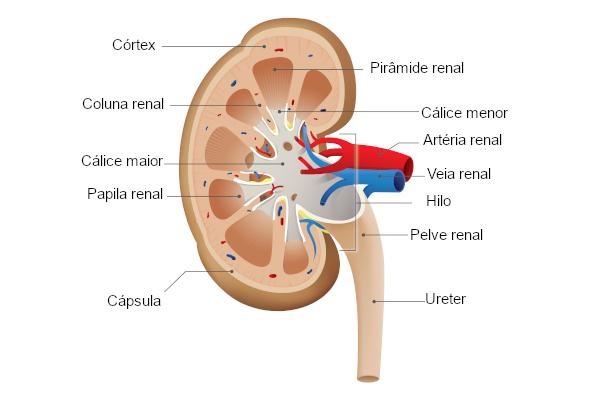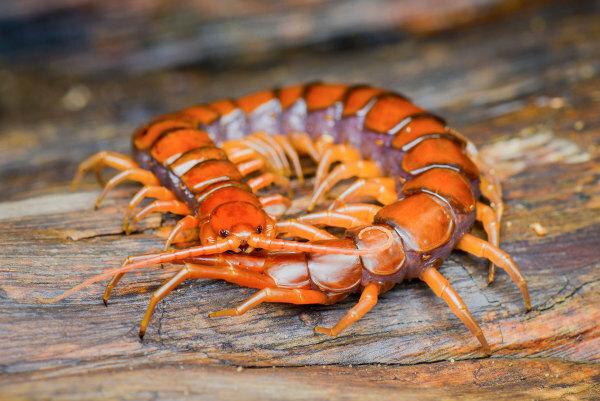You kidneys are organs of the urinary system related, among other functions, with the control of the concentration of substances in our blood. In the kidneys, urine is formed, more precisely, in the nephrons, its functional units. With the appearance of beans, the kidneys are found in number two in our body and have two well-defined regions: o cortex and the marrow.
The kidneys are essential for the proper functioning of our body, and care is needed to ensure its proper functioning. Among such measures, the following stand out: a water intake it's the reduced consumption of salts. Kidney failure and kidney stones are two problems that can affect them.
See too:Urinary system - responsible for forming and eliminating urine out of the body
kidney structure
Shaped similar to two bean seeds, this organ is located in the region behind the parietal peritoneum, against the muscles of the posterior abdominal wall and above the waist. Due to the location of the liver, usually the right kidney is a little lower than the left. On average, the human kidney is 10 cm long.
each kidney is surrounded by three capsules, which are called: true, perirenal fat and renal fascia. The entire kidney is coated by real capsule, which is a fibrous membrane intimately glued to the surface of the organ. Linking the kidney to the surrounding tissues, the renal fascia, which is a thin fibrous layer. Between the fascia and the true capsule, there is adipose tissue, a perirenal fat.

The kidney has a convex and a concave side, and on this last surface there is a fissure that is named after hilo. It is at the hilum that vessels, nerves and ureters enter and exit.
The kidney has a darker colored middle layer (marrow) and a lighter peripheral layer (cortex). These two regions receive blood through the renal artery and are drained through the renal vein. There is also a structure called renal pelvis, responsible for collecting urine. The pelvis branches towards the medulla, forming larger calyxes and smaller calyxes.
Do not stop now... There's more after the advertising ;)
In the renal medulla, we find the kidney pyramids, structures that have a cone shape. The base of each pyramid faces the cortex, and the apex ends in a papilla that flows into the smaller chalice. The cortex extends from the true capsule to the base of the renal pyramids and is also found between these structures, forming the renal columns.
You nephrons they are the functional structures of the kidney, in which blood filtration and urine formation occur. Each nephron is formed by a renal corpuscle and a tubule. The corpuscle consists of a tangle of capillaries (glomerulus) surrounded by a structure called the glomerular capsule or Bowman's capsule.
From this capsule comes a large tubule, called nephric tubule, which can be divided into: proximal convoluted tubule, loop of Henle (also called intermediate segment) and distal convoluted tubule. In each kidney, there are about 600,000 to 800,000 nephrons. Some authors even claim that this number could reach 1 million.

kidney function
The kidneys are responsible for ensuring the excretion and the osmoregulation (control of salt concentrations in the fabrics and cells). They are the ones that remove the products of cell metabolism from the cell and substances that are found in very high amounts in the body, thus ensuring the homeostasis of body fluids.
The kidney guarantees the removal of these products through the urine formation, which occurs in nephrons. In the glomeruli, the blood is under high pressure, which causes a part of the blood plasma to leave them and pass into the glomerular capsule.
In this process, known as filtration, we have the formation of the so-called filtrate, very similar to plasma. The filtrate then proceeds through the nephric tubule, where reabsorption and secretion of substances complete the process of urine formation.
kidney diseases
Several problems can affect our kidneys, causing symptoms, such as: swelling in the legs, difficulty urinating, pain when urinating, increased urination during the night, blood with urine, and lower back pain. Among the main known kidney diseases are:
Kidney calculus: popularly known as “kidney stone”, it is the result of the accumulation of some substances, such as calcium and cystine, inside the kidneys or urinary tracts. Several factors are related to the formation of calculi, among which we can mention: inadequate nutrition, heredity and low water intake.
Acute kidney failure: it is characterized by sudden loss of kidney function. It usually occurs as a consequence of some other health problem. This type of failure can be reversible, but in some cases it can be fatal.
Chronic kidney failure: it is characterized by progressive and irreversible loss of kidney function. We have end-stage chronic renal failure, when the kidneys have lost between 85% and 90% of their function. In this case, the patient must start procedures, such as hemodialysis.
Read too:Urinary infection - causative agents, diagnosis and treatment
kidney care
The kidney, as said, is essential to maintain the proper functioning of our body. For this, you must take some care so that it continues to perform its functions. Among the main medical recommendations are:
Do not consume too much salt;
Drink the proper amount of water;
No smoke;
Maintain the ideal weight;
Perform physical activities;
control the diabetes and the pressure.
In addition, it is important that periodic evaluations of this organ, since prevention is the best medicine for several diseases.
Read too: Importance of water for the human body
World Kidney Day
World Kidney Day is celebrated in second Thursday of March. The purpose of this day, created by the International Society of Nephrology, is to raise people's awareness about the importance of the kidneys for the functioning of our body and the need to ensure health renal. The date is also a time to learn more about kidney diseases, how to diagnose them, how to prevent them and how to treat them.
By Vanessa Sardinha dos Santos
Biology teacher


